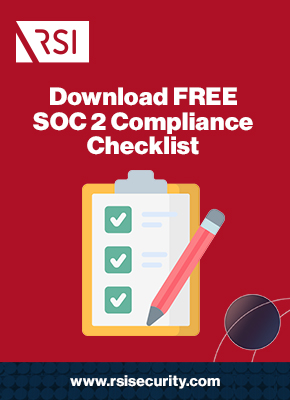The American Institute of CPAs (AICPA) has determined a set of requirements your company may need to follow if it is a “service organization” that stores sensitive user data on the cloud. These requirements are known as Security Organization Controls (SOC), and audits to ensure they’re in place are referred to as SOC reporting.
Read on to learn what a SOC 2 report is, whether you need one, and how to get a SOC 2 report if you need (or want) one.
What is a SOC 2 Report And Do You Need One?
If your company is engaged in business practices that involve storing or processing sensitive client data on cloud servers, there’s a good chance you’ll need to achieve some form of SOC compliance. What that compliance looks like can vary depending on your company.
This guide will break down everything you need to know about SOC 2 reports, covering:
- What a SOC 2 Type 1 report is, how to do it, and the pros and cons of getting one
- What a SOC 2 Type 2 report is, examples, and best practices for getting one
- What other types of SOC there are and what security principles inform them
By the end of this blog, you’ll know the different types of SOC reporting inside and out, and we’ll provide valuable resources to help you accomplish your own, should you need or want one.
SOC 2 Type 1 Reporting: Snapshot of Security in Place
A SOC 2 Type 1 report is a document that shows the state of your company’s security relative to its processing, storage, or other uses of protected user information. Often these uses pertain to information your service organization is hosting on cloud servers or similar platforms.
A type 1 report is not a longitudinal study. It’s a report on things as they are at a given moment.
Your company might need a SOC 2 Type 1 report if you have to show proof of a certain level of security, whether for legal or business reasons. For example, local laws in a given town or city might require SOC 2 Type 1 reporting at regular intervals. Or, a client might require (or expect) your SOC 2 Type 1 report as part of your initial pitch or ongoing contract negotiations.
Assess your SOC 2 Compliance
SOC 2 Reporting Process — Pros and Cons for Type 1
A SOC 2 Type 1 report follows a relatively straightforward process. The independent auditor will select a time to assess the organization’s security practices; then, the auditor will begin a detailed monitoring process to determine its implementation of SOC criteria (see below). There are a few distinct advantages and disadvantages to this system, including:
- Pro – SOC 2 Type 1 reporting is accessible. It’s a fast, easy, and low-cost process.
- Con – SOC 2 Type 1 reporting doesn’t guarantee long-term security to stakeholders.
- Pro – SOC 2 Type 1 reporting sets the stage for more robust Type 2 reporting later.
The pros of a SOC 2 Type 1 report generally outweigh the cons for most companies — especially when the Type 1 report is a stepping stone to a more robust Type 2 report in the future.

SOC 2 Type 2 Reporting: Security Over the Long Term
Unlike a SOC 2 Type 1 report, a Type 2 report is a longitudinal look at maintaining your service organization’s security practices. Often, the stretch studied is at least nine months long. A SOC 2 Type 2 report is like a Type 1 report stretched out over all moments between the start and end date rather than at just one specific point.
Your company might need or want to undertake a SOC 2 Type 2 report to provide the most comprehensive and up-to-date information about its security practices to a government body or potential client. SOC 2 Type 2 reporting instills confidence in your ability to keep clients’ data safe over the long term. It’s a mark of excellence over time.
Here are a few more articles to help you learn more about SOC 2 :
SOC 2 Type 2 Report Example and Best Practices
A characteristic of SOC 2 Type 2 reporting is that there is no set way that it must look. The AICPA provides general principles or criteria the report should focus on (more on these below) but otherwise leaves the format up to reporters’ discretion. Reports are meant to be illustrative. To that effect, AICPA also provides an illustrative sample SOC type 2 report available for download. Major takeaways from this SOC 2 report example include:
- Not all principles, criteria, and controls need to be reported.
- The period reported is one calendar year, but it does not need to be that duration.
- There is a primary but not exhaustive focus on cloud controls and cloud security.
Since the example should be illustrative, service organizations do not need to follow it verbatim. Nevertheless, mirroring its scope is one way to ensure success.
SOC 1, 2, and 3 and AICPA’s Trusted Service Criteria
There are three numbered categories of SOC, each relating to different AICPA security metrics:
- SOC 1: Internal Control over Financial Reporting (ICFR) – Referring to ATC-320, this standard is primarily concerned with users’ financial statements and security.
- SOC 2: Trusted Service Criteria (TSC) – Referring to the much broader TSC, this standard is dedicated to ensuring five security principles are upheld: security, availability, processing integrity, confidentiality, and privacy (see below for detailed definitions).
- SOC 3: TSC for General Use Report – Also referring to the TSC, this standard is designed for more generalized, public usages and is more streamlined.
While SOC 1 and SOC 2 are both intended for similar audiences, they utilize different standards and measure different outcomes. However, the same Trusted Service Criteria (TSC) are used for Type 1 and Type 2 SOC 2 and SOC 3 reports.

Understanding the Scope of the AICPA’s TSC and SOC
SOC 2 and 3 reporting of both types is based upon the Trust Service Criteria, formerly known as Trust Service Principles. These TSP/TSC break down as follows:
- Security – Restrict access to sensitive information based on authorization.
- Availability – Make data processing accessible for authorized parties.
- Processing Integrity – Ensure validity and correctness of security and logging operations.
- Confidentiality – Protect information deemed important.
- Privacy – Restrict the use and transfer of personal identifiers within sensitive data.
For many companies, the best way to ensure these and other cybersecurity principles is to work with an IT service provider. The talented team at RSI Security can facilitate all compliance and security needs.
How to Get a SOC 2 Report and Optimize Security
The sections above detailed what a SOC 2 (or SOC 1 or 3) report is and why you might want or need to complete one. We also discussed how to get a SOC 2 report if you do.
At RSI Security, we understand that many companies struggle less with understanding whether the report is needed and more with actually putting resources together to complete it. That’s why we offer a comprehensive suite of SOC 2 reporting services. To see how much easier and better compliance can be with the help of a dedicated professional team, contact RSI Security today!

